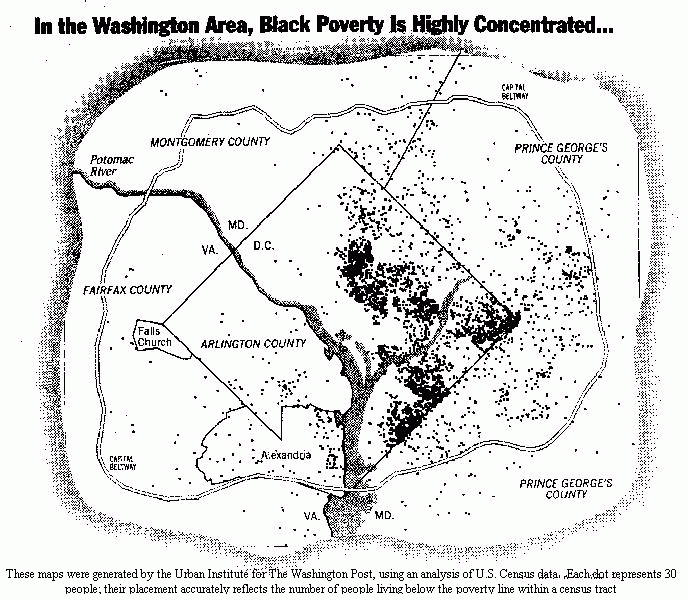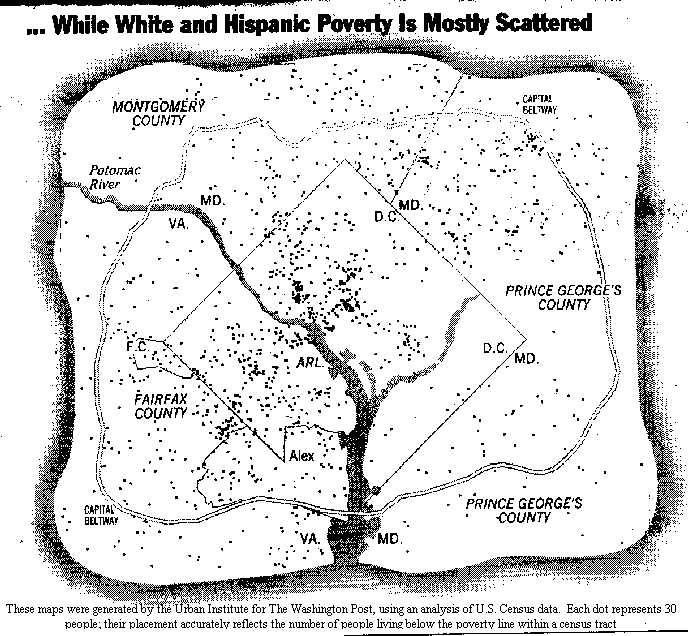
Conventional wisdom holds that poor people naturally cluster in poor neighborhoods, and that high-poverty, inner-city communities are the inevitable result. But the conventional wisdom is wrong. In the Washington metropolitan area, white and Hispanic poor people are widely scattered throughout the region's suburban neighborhoods, while many poor African Americans are living in highly concentrated pockets of poverty in the inner city. An analysis of census data reveals the starkness of the region's residential segregation: Poor blacks are four times more likely than the non-black poor to live in the District and 14 times more likely to live in a neighborhood with a high concentration of poverty.


This kind of geographic concentration exacerbates the consequences of poverty. When poverty rates exceed 30 percent (my definition for a high-poverty area), neighborhoods have great difficulty sustaining the economic and civic institutions essential for a healthy community. Poor education, joblessness, teen parenthood, discrimination and crime all reinforce one another, fueling a vicious cycle of poverty, inequality, isolation and social distress.
A new study of 1990 U.S. Census data, conducted by the Urban Institute, shows:
Poverty is highly segregated. Sixty-one percent of poor blacks in the metropolitan area live inside the District; 85 percent of the region's non-black poor live outside the District.
Black poverty is highly concentrated, while white and Hispanic poverty is highly dispersed. Twenty-six percent of the region's poor blacks live in a high-poverty, inner-city neighborhood, compared with only 2 percent of the non-black poor.
In the Washington area's high-poverty neighborhoods, all of which are located within the District, almost half the adults lack a high school diploma, compared with only 15 percent for the metropolitan region as a whole. Unemployment is nearly four times greater in these poor neighborhoods than in the metropolitan area, and almost three-quarters of families with children are headed by single women, compared with only one-quarter of families throughout the region. Moreover, as an increasing share of jobs migrate to the suburbs, poor African American communities in the central city are being cut off from access to economic opportunities.
As relative newcomers to the Washington metropolitan area, poor Hispanics have thus far avoided this kind of concentrated, inner-city poverty. The region's total Hispanic population more than doubled between 1980 and 1990, to 213,000. But only about 5 percent of poor Hispanics live in high-poverty neighborhoods, and only 25 percent of the Hispanic poor live in the District at all.
Housing discrimination and racial segregation in the Washington metropolitan region play a critical role in determining where poor people live. Poor non-black families are more likely to have access to housing opportunities in low-poverty communities throughout the metropolitan area, while their African American counterparts are far more often confined to the poorest and most distressed neighborhoods.
The Washington region has made some progress in opening up housing opportunities for African Americans. Between 1980 and 1990, the share of the area's poor African Americans living in the District dropped from 68 percent to 61 percent. And a growing number of affluent neighborhoods in the region are majority black or ethnically mixed, creating wider opportunities for people of all ethnic and racial groups.
But discrimination still persists; in February, the Fair Housing Council of Greater Washington released the results of its latest paired testing study, showing that minority apartment seekers experience discrimination more than two out of every five times that they try to rent an apartment in the Washington area.
The concentration of black poverty in our region demonstrates the continued need to combat longstanding patterns of discrimination and segregation. One promising initiative is a newly formed consortium of all the public housing authorities in the region, committed to expanding location choices for families who receive federal housing vouchers. This consortium, spearheaded by the Prince George's County housing authority and coordinated by the regional Council of Governments, has received multiyear funding from the Department of Housing and Urban Development. Over the next five years, its members will work together to craft region-wide strategies for helping poor families find housing in neighborhoods that offer them the best chances for upward mobility and economic independence.
Highly concentrated, inner-city poverty threatens the future of individual families, undermines the health of neighborhoods, drains city finances and polarizes our metropolitan community. The Washington region has made significant progress in recent years in opening up access to suburban and low-poverty communities for African Americans and Hispanics. But unless we explicitly attack the racial segregation that concentrates inner-city poverty, efforts to revitalize distressed communities and ensure equal opportunity for all poor Washingtonians cannot succeed.
Margery Austin Turner is a principal research associate at the Urban Institute. This article is based on the first of a series of reports on neighborhoods in the Washington region. Her views do not necessarily reflect those of the Urban Institute.
© Copyright 1997 The Washington Post Company